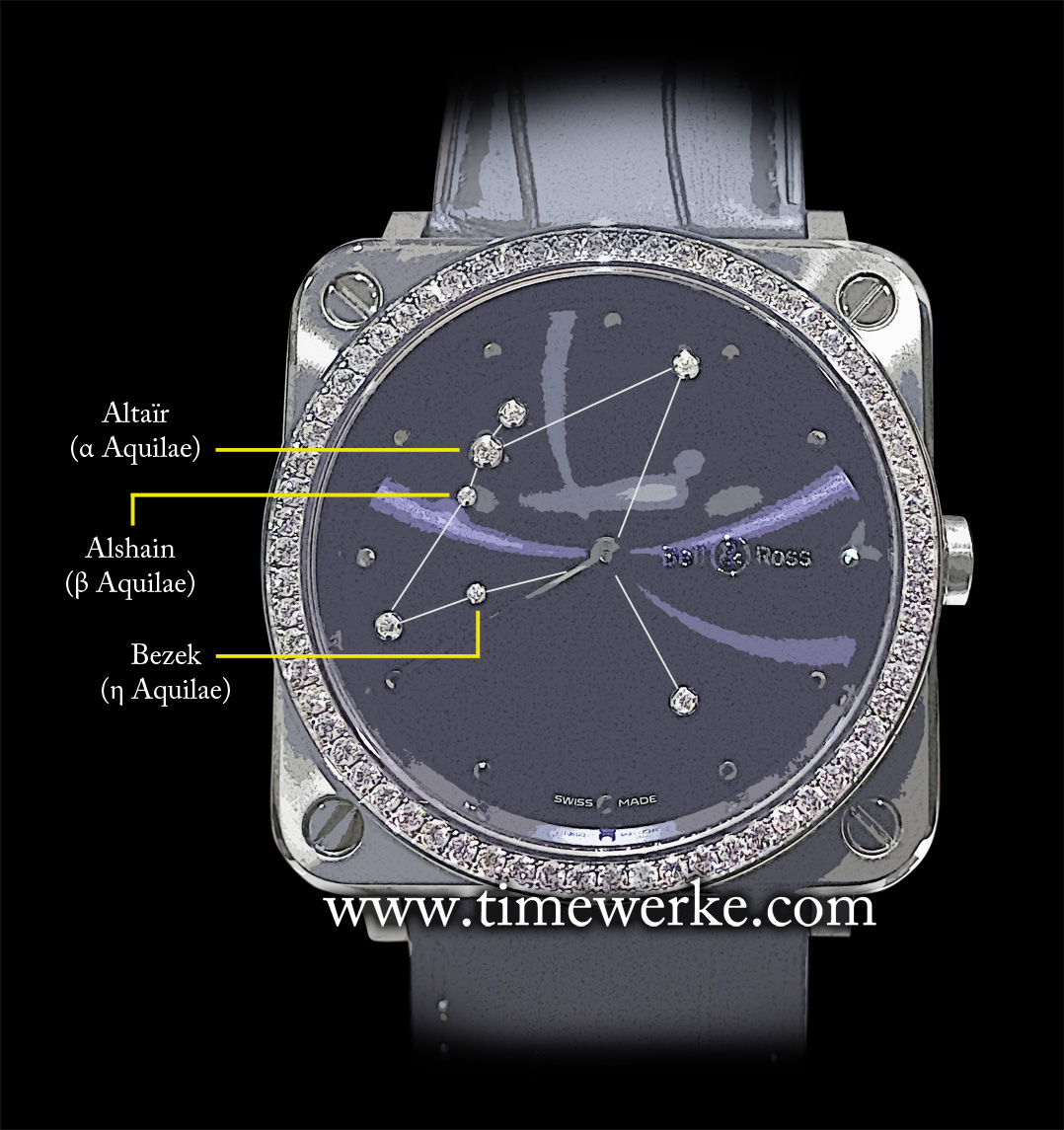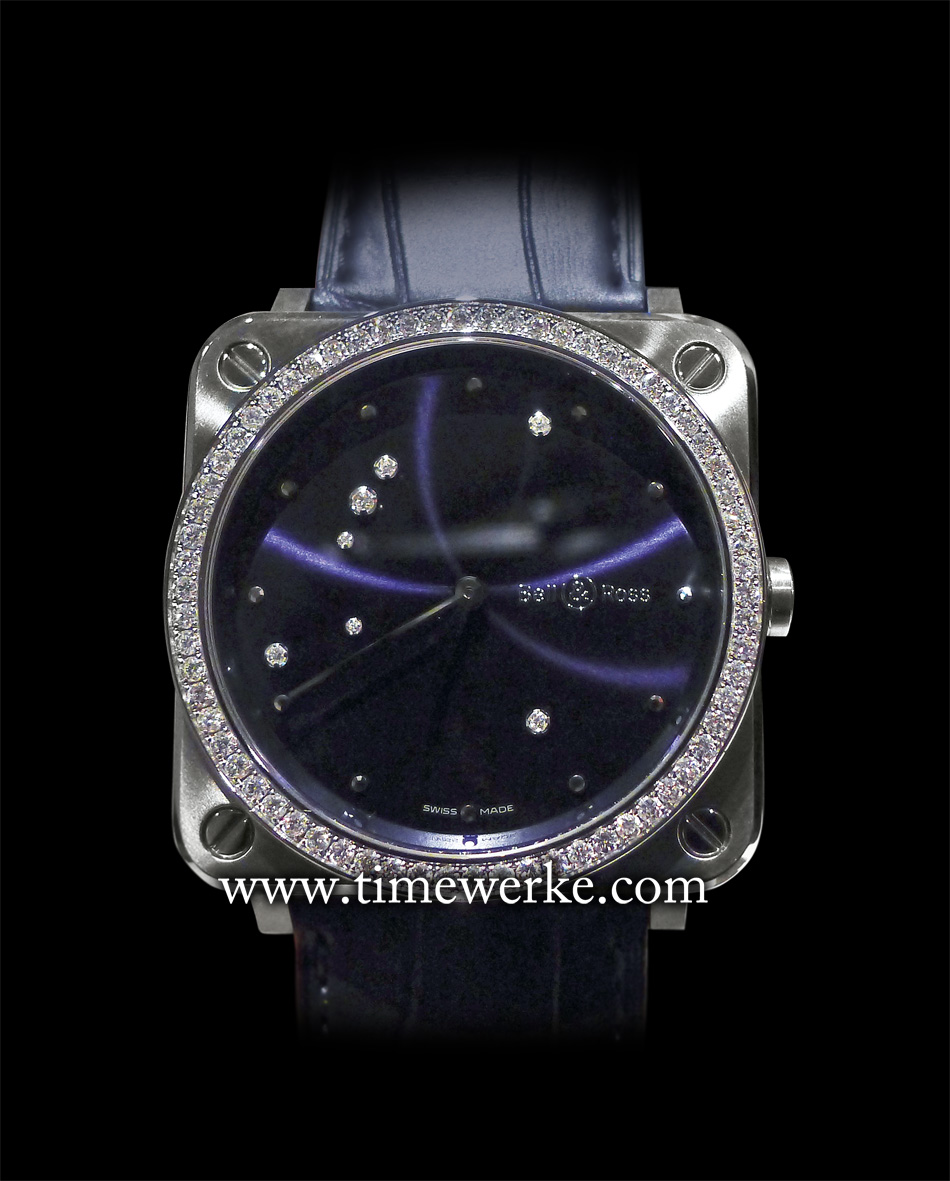
Look beyond its aesthetics and the feminine Bell & Ross BR S Diamond Eagle becomes a truly meaningful watch associated with the stars in the night sky, namely the Aquila Constellation. Photo: © TANG Portfolio. BaselWorld 2016. Special thanks to Axelle Rogano.
It isn’t the 1889 oil on canvas painting by Vincent van Gogh, but “the starry night” is what came instantly to mind when we first caught sight of the Bell & Ross BR S Diamond Eagle at the 2016 BaselWorld watch fair.
This is because the combination of seven diamonds set on the dial together with the sunray-patterned blue-tinted varnished dial, described as midnight blue, easily creates the appearance of stars in the sky.
It is in fact, no ordinary blue sky for the seven diamonds and the centre of the dial form the Aquila constellation. By forming imaginary lines linking the diamonds and the centre of the dial, the pattern obtained will be similar to that seen in the night skies of the Aquila constellation.
The pattern also looks like a bird, namely an eagle, in flight with its wings spread. Hence the name “Aquila” which in Latin means “eagle”.

By linking the diamonds and the centre of the dial, the Aquila constellation becomes apparent on the dial of the Bell & Ross BR S Diamond Eagle. The pattern formed is said to be an eagle in flight with its wings spread. Illustration: © TANG Portfolio. BaselWorld 2016.
The Aquila constellation is found in the northern sky and near the celestial equator.
The Aquila constellation represents the eagle of the Roman god Jupiter. Jupiter was the god of thunder, lightning and storms. He was also regarded as the supreme god.
In Greek mythology, Aquila is the eagle that carried the thunderbolts of Zeus (the Roman equivalent of Zeus is Jupiter).
Greek astronomer and mathematician Ptolemy or Claudius Ptolamaeus (circa 100 CE to 170 CE) was the first to catalogue Altair during the second century.
The brightest star in the Aquila constellation is Altair which is derived from the Arabic word al-nasr al-ta’ir which can either mean “flying eagle” or “vulture”.
Understandably, Altair is represented by the largest diamond set on the dial of the Bell & Ross BR S Diamond Eagle.

Bell & Ross BR S Diamond Eagle, introduced in 2016. Powered by the BR 102 quartz movement and housed in a 39mm steel case, the dial of the BR S features the Aquila constellation when imaginary lines link the seven diamonds together with the centre of the dial. The BR S Diamond Eagle is water-resistant to 100m. Photo: © TANG Portfolio. BaselWorld 2016.
The Constellation Guide highlights that Altair is actually the 12th brightest star in the sky with an apparent visual magnitude of 0.77. Altair is 16.8 light years away and it is one of the closest stars to Earth that is visible to the naked eye.
Altair is also associated with Zhinu, a fairy and the seventh daughter of the Goddess of Heaven, as pointed out by the Encyclopaedia Brittanica. Zhinu came to earth and fell in love with Niulang, a kind-hearted cowherd.
They got married and Zhinu became a weaver girl. When the Goddess of Heaven discovered that her daughter had married a mortal, she brought her back to the heavens.
Niulang somehow managed to get himself together with their two children to heaven to look for his wife, Zhinu. However, the Goddess of Heaven created a “river” to separate husband and wife. This “river” then became known as the Milky Way.
Niulang became the star Altair while Zhinu was transformed to the star Vega.
The world’s magpies got to know of the couple’s plight and subsequently flew to heaven to form a magpie bridge over the “river” (Milky Way) to allow Niulang and Zhinu to meet.
Touched by the love they had for each other, the Goddess of Heaven subsequently allowed both to meet on the magpie bridge on that particular day every year – that being the seventh day of the seventh lunar month.
Known as the Double Seventh Festival of Qixi, it is the Chinese equivalent of Valentine’s Day and falls sometime between late July and late August every year based on the Gregorian calendar.
Does this perhaps also explain why there are only seven diamonds set on the dial to represent Aquila?
In 2016, Qixi will fall on 9 August and the festival will be held on 28 August in 2017.


